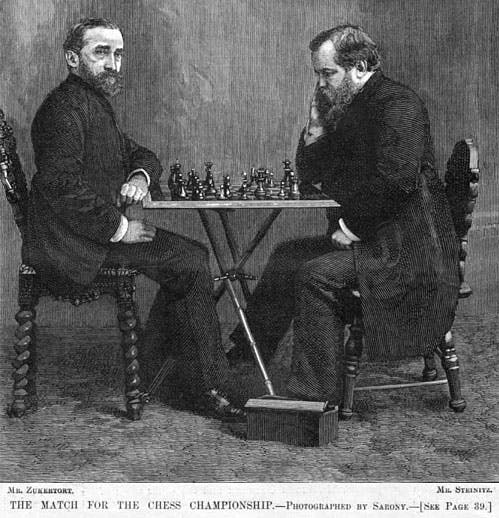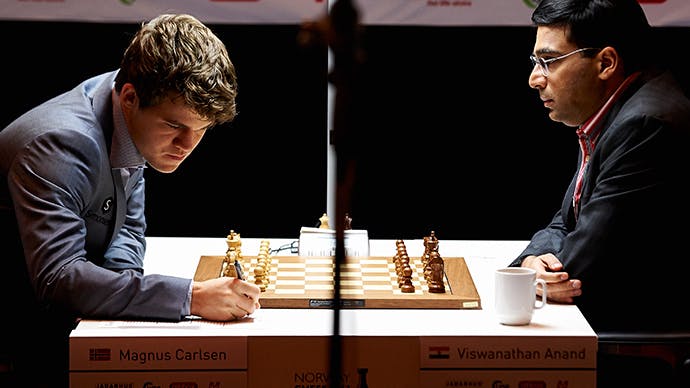Are you sure you want to delete your account?
(This will permanently delete all of your data - purchases, game scores, ratings, etc)
Change your username
Your current username is: guest
Change your account email address
Your current account email is:
Redeem your Fampay code here!
Use your Fampay code to get access to the Play Magnus Plus Membership!

A Brief History of Chess
Many of us frequent a chess table with a friend or entertain ourselves with a game of Play Magnus, while others have dedicated their lives to perfecting the game, but no matter what our relationship to chess is, how often do we ponder its origin?
The Birthplace of Chess
Although the initial creation of chess is not recorded, historians have devoted their best efforts to determine the birthplace of the game. The most widely accepted scenario is that chess was developed in India around 600 AD.
It is rumoured that the ruler of the Gupta Empire in India at the time called upon his wise men to develop a game that would teach his children to become strategically minded and capable future generals. As per his request, the game Chatarunga, meaning “four divisions” in Sanskrit, was introduced to India. The four divisions represented infantry, cavalry, elephants and chariots; the predecessors to the pawns, knights, bishops and rooks we know today.
The Spread to Persia
A close neighbour to India at the time, Sassanid Persia was first introduced to chess by Raja Hind of India as detailed in the Shahnama, the ‘Book of Kings’. Persia’s culture greatly influenced the development of the game and it’s name changed to Chatrang.
Various other name changes and phrases were introduced, most famously ‘Shāh!’ (Persian for ‘King!’), which has developed into ‘check’, and ‘Shāh māt!’ (Persian for ‘the King is finished!’), the ancestor of ‘checkmate’. After the Islamic conquest of Persia, the name became ‘Shatranj’ in Arabic, and was brought to Europe by the Moors in the 10th Century AD.
Into Europe
By the year 1000, the game of chess had become widespread across Europe. For the next 500 years, chess remained very similar to the original Indo-Arabic game. Apart from translations and name changes in different countries, the rules stayed true to their origins.
As the age of curiosity, experimentation, and enlightenment arrived with the Renaissance, the rules of chess began to be developed alongside culture and science. Part of the intention of modernizing the rules was to quicken the pace of the game by bringing the pieces into combat earlier.

New Rules, New Game
With the new rules, the king could jump once, allowing the chief piece to reach the safety of the corner sooner. This rule later developed into castling. In Indo-Arabic chess, the queen was called the counsellor, and the piece’s movement was even more limited than the king’s! The counsellor could only move one step in the diagonal direction.
The European development of the game had the piece renamed to queen, allowed for the promotion of pawns upon reaching the opposite side of the board, and most drastically, changed the movement of the queen to the rules we use today.
Another change allowed the pawns to initially move forward two spaces, allowing for the en passant rule to be introduced.
These new rules dramatically changed the nature of chess. The game evolved from a slow-paced war simulator to a fast moving sport. The openings of each game were now rapid and filled with gambits and fierce attacks.
One more controversial aspect that developed was the increasing number of games resulting in draws. The Indo-Arabic game of chess was won in three different ways: by mating the king, by giving stalemate, or by capturing all the enemy pieces. This allowed for the majority of games to end with a clear winner or loser.
The new European version of chess could only be won by mating the king or by the resignation of the opposing player. These conditions of victory increased the likelihood of draws as well as the necessity and viability of specific strategies and tactics that could be studied and shared.
Through the Silk Road
Chess did not only develop a new branch in Europe. The silk road allowed for chess to find popularity in Eastern Asia, specifically in China and Japan. From the middle east to the far east, the rules found their own route, developing into the game Xiangqi in China and Shogi in Japan. With distinct rules such as the placement of pieces on lines instead of inside squares, as well as a limited box for the movement of the general (equivalent of the king), Xiangqi has maintained its own popularity throughout the years and is still played today. The chess variant Shogi in Japan also diverged towards interesting rules, as captured pieces could be returned to the board to fight for the opposing side.
Modern Chess
As chess rose in popularity and evolved into faster paced games with the development of new rules, professional play was introduced. The first tournament took place in London in 1851, with the world championship debuting in 1886.
In the over half century span between the first world championship and 1940, the title of World Champion was only enjoyed by five different players. For 27 years the title was held by the German mathematician Emanuel Lasker, who still maintains the record for longest period as World Champion.
In the 20th century, the style of chess play evolved greatly as strategies and tactics were further modernized. The more aggressive play style of the Cuban player José Raúl Capablanca won the title from Lasker in 1921, and the common objective to control the centre of the board developed in the period between the world wars.
Some believe the first grandmaster titles were initially awarded by Tsar Nicholas II of Russia, but with the establishment of FIDE (the World Chess Federation) in 1924, came the official start of this tradition.
After the death of the World Champion Alexander Alekhine in 1946, a world championship was held in 1948 to determine a new titleholder.
The victory of Mikhail Botvinnik launched a period of Soviet domination of chess until the American Bobby Fischer was proclaimed World Champion in 1972. Following a dispute with FIDE, Fischer defaulted the title of World Champion to Anatoly Karpov in 1975 who reigned until 1985 when he was defeated by Garry Kasparov. The two would continue to battle for the title for decades, with Kasparov eventually forfeiting the title back to Karpov when he left FIDE in 1993.

The following years saw the return of a more internationally balanced competition, with players representing a range of nationalities capturing the title such as Viswanathan Anand from India, Ruslan Ponomariov from Ukraine, Rustam Kasimdzhanov from Uzbekistan and Veselin Topalov from Bulgaria.
Current world champion, Magnus Carlsen, gained the title upon defeating Anand in 2013 and in 2014 became the highest ranked chess player in history. Looking towards the future, the next world championship of chess will face the formidable Magnus Carlsen against Sergey Karjakin, the record holder for the world’s youngest grandmaster.

Begin your own chess history today!
